Gedling House
In 1995 Torven Zeffert completed an MA in Building Conservation on the history of Gedling House.
Torven has very kindly agreed to allow us to show this material below.
The original documentation is available on Torven’s website here: Torven Zeffertt
(note: as of 2023 Torven’s website is no longer available but can be seen by using the WayBackMachine web archive at https://web.archive.org/web/20210927074508/https://zeffertt.uk/index.php/gedling-house)
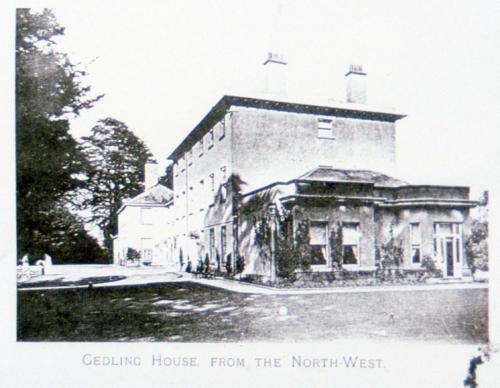
Introduction
For my MA Building Conservation dissertation written in 1995 I undertook a history of Gedling House.I thought there might be some interest in my dissertation as it shows the history and development of the house in the late eighteenth and earlier nineteenth centuries so I’m gradually uploading it here.
Previously the house had only been studied from a stylistic perspective and I thought the archive material I’d looked at might be of interest to some. I’ve left off the pictures for now but hope to add most of them at a later date. When I have the time and inclination I’ll add details of new studies as well. There is a copy of the original at the Local Studies Library, Angel Row, Nottingham.
My interest in Gedling House sprang from the fact that as a young family we used to walk through the grounds and went blackberry and raspberry picking in the overgrown walled garden. The grounds have been off limits for a long time and the overgrown walled garden is now a car park. However, Gedling Woods still makes for a great short walk.
The Owners
Through the history of Gedling House it is possible to follow a property through the late Georgian and early Victorian periods, and to see the styles and influences that affected its development. The study area comprises Gedling House, a grade II listed building (DoE 1987), and the surrounding grounds, an area of some 70 acres (Fig 1). Although the property has been described (Pevsner 1979 132; Gerring 1908 165-6) it has never previously been formally studied in great detail, so for this study it was necessary to look at some very basic archive sources to confirm historic information, such as the earliest owners and the possible date of construction.
Other areas that need to be looked at in the early development were the influence of James Paine junior, the Reverend John Swete and local builders Samuel and William Stretton, and the relationship between Gedling House and Bridgford Hill House, East Bridgford. While much of the archive is easily accessible it has not previously been assembled in a coherent form.
It is not possible to study buildings in aesthetic independence from their cultural, social and economic context. The reason for their being built and being occupied need to be properly understood. The history of buildings is also about people, not just the building materials.

In looking at the estate the land that does not form part of a coherent landscape design is ignored, as in this study it is only intended to look at that area which forms part of the immediate landscape of Gedling House in the late Georgian and early Victorian periods. The peripheral farmlands form a large part of the estate but they are not part of the impact the owners wanted to have on the landscape of the Trent Valley.
The dates chosen to confine this study are from c.1790 to c.1850 and were chosen to reflect the major period of development of the house and estate, and covers the period of ownership by the two people who had most influence on that development. The first date derives from the period around which the first owner, Thomas Smith, was building up the estate in the run up to the Gedling enclosure and the construction of the house. It is to the earlier years of ownership that most of the development of the house can be placed. The final date is drawn from the time just after the death in 1844 of the second owner, William Elliott Elliott, but allows for speculation on changes made shortly after.
The remainder of chapter one deals with some of the basic background information that is needed to understand the history of the house and the more important source material used to reconstruct that history. Chapter Two is a discussion of the early owners of the house, which not only provides a context for the local historical development within which the house can be placed, but also shows how the fortunes of a house are linked to those of the owners.
A study of the background of the house and the eighteenth century influences on the style is undertaken in chapter three. Several sources suggest that James Paine Junior advised and influenced the original design. The possibility that one of the better known contemporary Nottingham builders had a hand also cannot be ignored. Some of the detail has certainly come from Georgian pattern books and similarity with other local buildings is apparent. Close family ties provide links with a number of surviving Nottingham buildings.
Chapter four provides an architectural study of the house, while the layout of the grounds is covered in chapter five. The final chapter provides a discussion of the conclusions that can be drawn from a study of Gedling House.
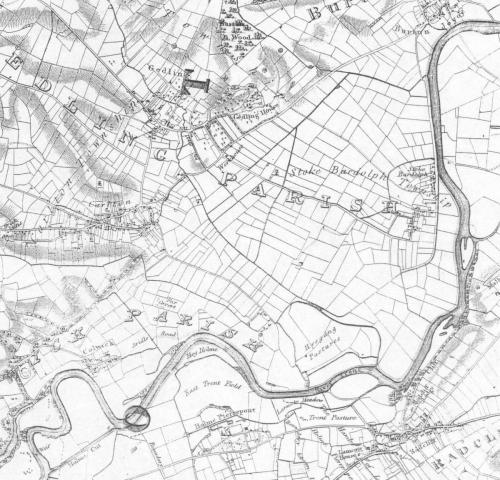
Location and Topography
Gedling House lies about five miles east of Nottingham, on the north side of the Trent Valley. The village of Gedling now forms the eastern limit of the suburban growth from Nottingham. The still identifiable village core, lying in a small valley, has been overshadowed by the colliery, railways and modern housing development.
In 1832 Gedling was a village with 458 inhabitants and could be described as ‘standing in a picturesque valley’ (White 671).
Until 1993 Gedling House was run by the Education Resources Department of Nottinghamshire County Council. They have now moved to the Sandfield Centre, Radford, while the house has reverted to private ownership.
The present owner is currently converting the house and outbuildings into flats and, that part of the garden still attached to the house is to be renovated.
A large part of the grounds have been taken up for use by Carlton-le-Willows Comprehensive School, which somewhat detracts from and masks the original layout. The extent of the house and grounds can be reconstructed both on the ground and from archive material.
Sources
While the main source of information is the house itself a number of other Nottinghamshire sources have proved invaluable in untangling the history of the estate. Three Nottingham resource centres were crucial in providing information on the house and the people involved: the Local Studies Library (LSL); Nottinghamshire Archive Office (NAO) and; the Nottingham County Council Education Resources based at the Sandfield Centre, Nottingham (SFC).
Written Sources and Local History
There are few directly useful local histories that discuss Gedling House, the most important being by Charles Gerring (1908 165). It is unfortunate that Gerring appears to have misread the title deeds, recording Jonas Bettison as the original owner in 1780. He provides useful photographic evidence of the house in the Edwardian period, complete with its new ballroom (Fig 3). Thomas Smith, the actual owner was recorded by Gerring as a witness to the title deeds. Other local histories barely mention the house, although just enough to reiterate Gerring’s date of 1780 for the construction of the house (Norfolk 1960; Swann 1985).
Nicholas Monsarrat, author of The Cruel Sea, wrote in his autobiography, Life is a Four Letter Word, of his Christmas visits to Gedling House in the early part of the twentieth century, providing the only written account of life in the house, albeit from the perspective of a child of six (1966 passim).
Both Thomas Smith and William E Elliott knew the local eighteenth century diarist Abigail Gawthern and there are a number of interesting and useful entries in her diary regarding them and, changes to the house and grounds (Henstock 1980 passim). Matthew Baker provides a second interesting and important contemporary source is the short description of the house and the garden temple (1835 131).
Nottingham Record Office
The record office holds an important series of papers relating to the estate between 1565-1803 (NAO: DD/LK/50). The eighteenth-century documents reveal how the land was built up by the Smiths and, how Thomas Smith consolidated his property and probably built the house in the mid-1790s. The 1803 documents refer to the sale of the house to William Elliott Elliott and provides a description of the layout at that time (Appendix 4). An important source for providing the most likely date for the construction of the house are the East Bridgford and Gedling Land Tax Assessments of 1781-1832 (NAO: QDE 1/4; Appendix 3) on microfiche at the Nottingham Record Office. These show Smith in ownership from at least 1780 up to 1803 and how he is increasing the amount of his property tax over this period.
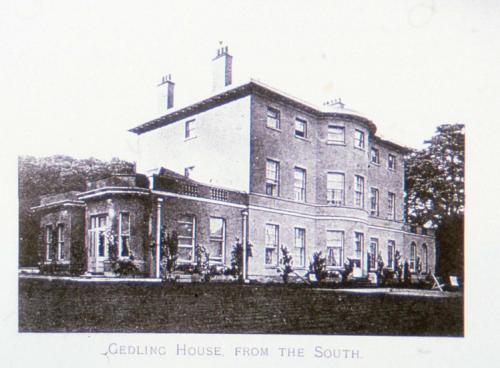
Education Resources, Sandfield Centre
The Education Resources were until recently based at Gedling House and they have built up a useful resource regarding the history of the house, especially in regard to the later occupants, the Burnside family and Sir John Turney. Of particular importance is the original watercolour by the Reverend John Swete of a smock mill in Gedling with the house in the background, painted in the early nineteenth century (Fig 4). A few short oral histories and notes of interviews provide a bit of colour for the occupancy of Sir John Turney in the early twentieth century, and give some idea of the social organisation of the house.
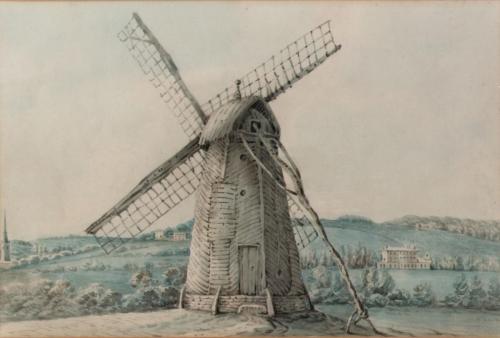
Georgian Nottingham, Social, Economic and Political Background
It is important to look at the effect of Georgian Nottingham on the owners of the house as the late eighteenth century was a period of social, political and industrial change and upheaval. The character of Georgian life had a direct influence on why and how the house was constructed and the economic changes provided the financial wherewithal for the owners to undertake the work.
The history of late eighteenth and early nineteenth century Nottingham has been fairly well studied (e.g. Chambers 1946; Meaby 1946; J. V. Beckett 1990). Christopher Hussey has discussed how the changes in eighteenth century architecture and taste are directly linked to changes in the economy and politics, “The neo-classical movement in architecture, the Romantic Revival and the cult of the Picturesque, are thus seen, with the revolutionary trends in industry and political thought, as facets of the new age” (1955 10).
Georgian Society
During the course of the eighteenth century the population of Nottingham increased without a corresponding increase in the land available for building. Between 1781 and 1801 the number of inhabitants increased by nearly 11,000. In 1785 the first back-to backs were built, and similar building continued well into the nineteenth century (Barley & Straw 1969). Although the worst Nottingham slums had not yet been built the population was growing within a confined urban area.
Nottingham had become associated with disorder and riots. For the period covering the building of Gedling House there were riots over food shortages, caused by poor harvests and exorbitant meat prices or, disaffection amongst framework knitters nearly every year. Nottingham was regarded as a hotspot of political disaffection from the 1780s until the early-nineteenth century (Wells 1984 passim).
As the towns attracted growing numbers of people more houses became crammed into every available space to accommodate the new industrial classes. As the quality of houses in the urban centre declined the new middle class began to look outside the towns to find a healthier and more invigorating place to live (Barley & Straw 1969).
Politics
The owners of Gedling House played an active part in the political life of Nottingham and Nottinghamshire. All the owners were freeholders, entitling them to vote in parliamentary elections (Reed 1983 15).
Thomas Smith was a close relation of Abel Smith and George Smith, members of parliament for Nottingham through the late-eighteenth century (Field 1880 passim). After George Smith was elevated to the peerage as Lord Carrington he became, because he was highly respected as a leading banker, the economic adviser to the Prime Minister, William Pitt.
William E. Elliott was High Sheriff of Nottingham in 1801, two years before moving to Gedling. Abigail Gawthern recorded in her diary for that year that Fanny Elliott (William’s wife) had several new diamonds (Henstock 1980 87). The year that Elliott moved to Gedling he was the Deputy Lieutenant of the Town and County of Nottingham. Both William E. Elliott and his brother John were Justices of the Peace for Nottinghamshire. The J.P.s were responsible for the administration of the counties, exercising wide judicial and administrative powers. They had to supervise road and bridge repair, the regulation of wages and the administration of poor law. By acts of parliament of 1732 and 1744 they had to possess landed estates worth more than £100 a year (Reed 1983 17).
The County Magistrates were all Tories, and often in conflict with the Whig hierarchy of the town. In March 1820 both William and John Elliott were involved in a Tory ‘take-over’ of the police offices in order to thwart the Whigs appointment of overseers to the workhouse (Field 1880 335).
John Stanford Elliott, William’s brother, was a colonel in the Nottingham Volunteer Infantry, and his commander was Samuel Smith, the banker. The volunteers were formed at a time when there was a threat of invasion from France by Napoleon Bonaparte and fear of French-style insurrection at home (Wells 1984 passim).
Economy
Although the real growth in the industry of the East Midlands did not occur until the 1840s a small economic boom took place in the eighteenth century. As will be seen in the chapter on the owners new local fortunes were being made from new trades. Of particular relevance are the banking fortunes of the Smiths and the textile fortunes of the Elliotts, Stanfords and, Burnsides.
Both of the early owners of Gedling House were the recipients of large fortunes from successful entrepreneurs. Thomas Smith received land in East Bridgford and Gedling, including part of the Gedling House estate, from his grandfather Abel Smith, a successful Nottingham banker and member of parliament. As well as owning a large country estate Thomas Smith was also the distributor of stamps in Nottingham, based at Bromley House, Nottingham, from at least 1792 until 1806, when he died. In 1798 he took out a mortgage on his land in Gedling to cover his liabilities up to £10,000. Samuel Smith and Lord Carrington also provided money for these liabilities (NAO: DD.LK.50/50).
William Elliott Elliott received most of his money and lands from his father, who in turn received it from his uncle, both called William Elliott. The uncle had built up his fortune during the eighteenth century after discovering and maintaining a monopoly on a method of dying black silk hose. The economic background of the towns of Georgian England in general is important for understanding the rise of provincial prosperity as it had a great impact on the building trade in and around Nottingham.
The Estate
Date of Construction
While it has not been possible to give an unequivocal date for the building of Gedling House it is possible to provide a date around which it was built. It has proved easier to disprove the dates that have been given than to give a truly compelling argument for the actual date of construction.
While it is agreed that the house is mid to late Georgian the actual dates given for construction ranges from 1780 to 1820. Gerring says it was built around 1780 (1908, 165), a date repeated by Norfolk (1960, 16). As the house is quite clearly not on the Enclosure map of 1796 (Fig 2) this is clearly too early.
Gerring records that the title of the property, owned by W. Bettison, was signed 14 October 1773; but as there are no further details it seems more likely that this refers to land sold to the Smiths (op. cit, 166).
The List of Buildings of Special Historic Interest dates the building to c.1820, presumably this is purely based on stylistic grounds (DoE 1987).
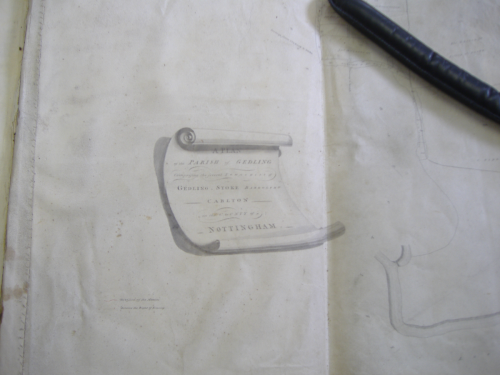
The Survey was undertaken from 1792. Thomas Smith can be clearly identified as the owner. A number of sources have already been mentioned that give grounds for supposing the house was built in the mid-1790s.
These sources are the maps, land tax assessments and title deeds. John Chapman’s Map of Nottinghamshire of 1774, not surprisingly, shows that there is no house at that period (Fig 6). Of more significance is the map accompanying the Enclosure Award of 1796 (Fig 5).
The Enclosure map shows that the land belonged to Thomas Smith and, that at the time the land was surveyed in 1792, there were no buildings and no woods on the site. The house could therefore have been built after the survey was undertaken but before the Enclosure Award was made, therefore between 1792 and 1796.
George Sanderson’s ‘Map of the Country Twenty Miles round Mansfield’, of 1835, is the first map that shows the house and grounds (Fig 7), but it does not really help in dating the construction as it is some forty years later than that date.
The Gedling Land Tax Assessment provides interesting information regarding the worth of Thomas Smith’s land and who occupied the land. The Land Tax was a tax on the ownership of land assessed and collected each year between 1692 and 1831, though assessments survive only from 1780 to 1832. The list gives no description of the property, but lists the owner, occupier and the amount of tax payable (Henstock 1988 57).
Gedling House estate can be identified in conjunction with other evidence from the owners name. From 1782 to 1803 the owner is given as Thomas Smith, after which William Elliott Elliott is named (NAO: QDE 1/4: Appendix 1). During the 1780s the land tax remains steady at £1 9s 6d. The tax increased in 1790 to £2 4s 7.5d, in 1791 to £2 4s 9.5d and, in 1792 to £2 4s 9.75d, at which point it remained the same until it was redeemed in 1802 (see APPENDIX).
What this tells us is that at a period, from 1790 to 1792, when the assessment on other landholders in Gedling remained static that on Thomas Smith was rising. The increase was presumably incurred due to an increase in the size of Smith’s estate and does not necessarily indicate any building activity.
The occupier of Smith’s estate is given as Thomas Hallam until 1795, as Thomas Smith and Thomas Hallam in 1796, and as Thomas Smith from 1797 until 1803. From 1795 or 1796 Thomas Smith occupied his land in Gedling and it is therefore possible that it is in these years that he built his mansion.
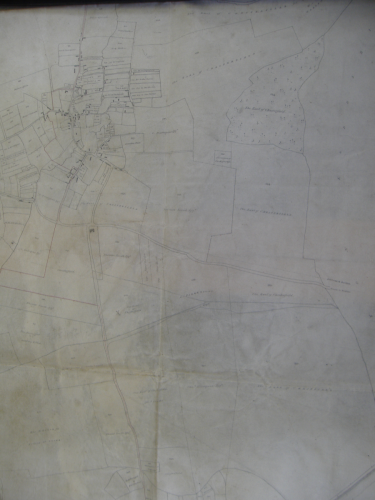
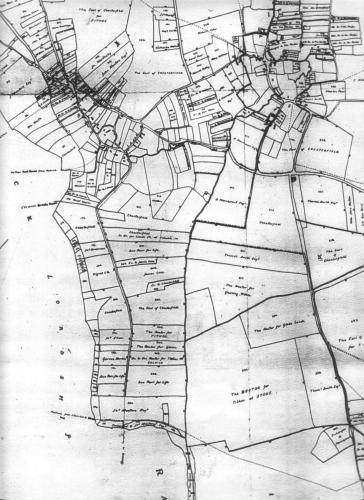
An excellent run of title deeds is extant that covers various parts of Gedling House estate from 1565 until 1804 (NAO: DD.LK 50/1-60). The deeds relating to Thomas Smith, and others connected to the house are housed at the archive office.
Copies of later deeds relating to the first half of the twentieth century from the offices of Larken & Co., solicitors, are housed at the Sandfield Centre. The title deeds and mortgages prove ownership at at any named point in time.
The earlier eighteenth century mortgages show the bankers Abel, Thomas and Samuel Smith to have been involved in the mortgaging and procurement of land that later became part of the Gedling House estate. (NAO: DD.LK 50/1-60).
In 1728 Sir Gervase and Dame Anne Clifton sold a house and land to Abel Smith, Thomas Smith’s grandfather (NAO: DD.LK 50/42-4). Thomas Smith (1682-1727), great uncle to Thomas Smith the builder of Gedling House, provided in 1727 a mortgage to Anne Hodge on a house and land in Westdale Field, Lambley Dale Field and Bleasdale Field. These lands are later part of Thomas Smiths estate and Bleasdale Field is the open field where Gedling House was constructed (NAO: DD.LK 50/25-6).
Jane Bower appears to have fallen behind with her mortgage interest payments and had a house and land repossessed by Abel Smith in 1742 (NAO: DD.LK 50/38-9). Thomas Smith’s name first appears in a title deed of 1781 in which he is providing a £500 mortgage to William Butler. This is of most interest because it says that Thomas Smith is a grandson of Abel Smith and that he is a banker (NAO: DD.LK 50/45-6).
In 1789 Thomas Smith is recorded as buying West Field, Lambley Dale Field, Bleasdale Field, Upper Meadow and Nether Meadow from from Robert Thorpe for £1,447 (NAO: DD.LK 50/40-1).
In 1790 Thomas Smith was granted a £10,000 mortgage on his land and buildings in Gedling from his cousins Samuel Smith and Robert Lord Carrington (DD.LK 50/49). To cover his liabilities as Distributor of Stamps for Nottinghamshire Thomas Smith raised a £10,000 mortgage from Samuel Smith and Lord Carrington, though no money actually changed hands (NAO: DD.LK 50/50).
Although it is possible to trace the accumulation of land in Gedling by the Smith family and that Thomas Smith was probably an owner of land in Gedling from at least 1781 what the title deeds do not show is the actual date at which he constructed his new house.
The Extent of the Estate
A clear picture of the full size and extent of the Gedling House estate can be built up from contemporary maps and the series of title deeds. In looking at the estate the land that doesn’t form part of the immediate landscape of Gedling House is ignored, as in this dissertation it is only intended to look at that part which forms a coherent statement. It is intended to concentrate on a core area of some 70 acres.
Although substantial the farm lands are not part of that statement of parochial landscape design. The map accompanying the Enclosure Award of 1796 shows that the land allotted to Thomas Smith matches closely in form to the area outlined on later maps for the house and grounds (Fig 5).
The auction catalogue of 1803 gives a description of the house and estate at the point of sale (NAO: DD.LK 50/50; see Appendix 4; Fig 8). It describes the main part of the estate:
“A Capital substantial newly-erected Mansion-House – consisting of Dining-room, Drawing-room, with Green-house adjoining; Breakfast- room, Parlour, Hall, two Staircases, Pantry, Store-rooms, Kitchen, Laundry, Brewhouse, Dairy, and sundry other convenient Offices; seven Bed-rooms, Water-closet, Servants’ Bed-rooms, three good Cellars, and lower Dairy: also a very convenient detached Yard containing a double Coach-house, excellent Stables and Saddle- house, a large Barn, Dovecot, Cow-houses, and other Buildings, with Rooms over them; Gardens and Orchards well stocked.
The Mansion-House, fronting South-East, is seated in the centre of rather more than 70A. of Land, comprised within a Ring-fence (and which will be sold with the House) forming a handsome Lawn in Front, with several thriving Plantations, and commanding an extensive and very beautiful prospect over the River Trent, and adjacent rich Vales, abounding with Game, and highly desirable to Gentlemen fond of Field Sport and Fishing” (NAO DD.LK 50/53).
While the important elements of the estate in this description are fairly clear the original maps which are said to accompany the catalogue are no longer extant.
A much clearer and more straightforward means to reconstruct the estate is provided by an 1868 ‘Plan of the Township of Gedling’ by a Nottingham land surveyor, John Bausor (NAO: GE 1 R; Fig 6) and its accompanying survey (NAO: PR 17250; Appendix 5). The northern boundary is covered by wood, planted by Smith or Elliott to provide woodland walks, which continues round to the west as a belt of trees.
The original boundary can be followed south by this belt, around Hall Wong and along the Burton Road to the south. Where it remains on the south boundary this planting is now somewhat thin and has been cut into for bus stops.
The White Lodge lies on the corner between the original western and southern boundaries, although the boundary was extended westwards in 1841. The boundary on the south east appears never to have had a belt of trees, which somewhat adds to the assertion that the owners desired to be able to see towards Bridgford Hill House, East Bridgford.
Fields to the north east are part of the estate but do not appear to have been part of the designed landscape. There is still a distinct boundary on the ground which can be traced and the main features of the design are extant, although, with Carlton-le-Willows School cutting across much of the grounds, the form is not entirely obvious without other evidence.

There were two possible approaches to the house, from the west along the present road leading to Wood Lane and Gedling, and from an entrance at The White Lodge along what is now a path. These details of the grounds are discussed further in chapter five.
Changes to the House and Grounds
A number of sources date changes made to the house and grounds, although none make it clear exactly what those changes were as they are either too short or incomplete. It appears that as new owners inherited the property they stamped their mark by adding to the house or grounds.
During the course of the nineteenth century the grounds were extended through the purchase of land. Fig. 9 ‘Plan of the Township of Gedling’ by a Nottingham land surveyor, John Bausor, 1868 (NAO: GE 1 R). The accompanying survey is included here as Appendix 5.
Abigail Gawthern provides an interesting and important entry in her diary for the 2nd of August 1806,
“We dined at Mr Elliot’s at Gedling; they have much improved the house, garden, and grounds.” (Henstock 1980 123).
She provides in such a short quote a tantalising hint of the major changes that may have occurred, and could have effected the whole estate between 1804 and 1806. It leaves unanswered numerous questions regarding who undertook various works to the mansion and raises the possibility of speculation about the extent to which the Elliott’s went in their improvements.
A note in the Sandfield Centre parish file for Gedling raises further questions which cannot be answered in full. Three plans are referred to in the note, two of which refer to alterations, and the other to detailed plans of the mansion.
The first alterations, with plans dated 22nd November 1844, were for William Burnside and and the second, dated July 1904, were for Walter Rawnsley. William Stanford Burnside inherited the estate when William E. Elliott died in 1844. W. Rawnsley inherited the estate in 1904 on the death of John Elliott Burnside.
We might presume that the 1904 plan refers to the conversion of the lean-to greenhouse, on the west side of the house, into the ballroom. Although the presumption may be wrong it is made due to the fact that the greenhouse disappears from the Ordnance Survey maps during this time (Fig 10).
The changes undertaken to the mansion in 1844 will again be pure speculation. The actual title deeds in the archive office and references to title deeds in Gerring provide evidence of some of the later additions to the immediate estate.
Over seven acres of land, called Hall Wong, was bought from Lord Chesterfield by William E. Elliott in November 1841 (1908 165). This was a narrow strip of land running from the Lodge towards Gedling Manor, and is only part of Hall Wong. In 1854 Lord Chesterfield sold a small area of unspecified land to William Stanford Burnside (ibid.). Further areas of land in Gedling was sold to the owners but as this is not part of the immediate estate it does not concern us.
The Gedling Enclosure
An important aspect to the period leading up to the construction of the house was the Enclosure Award of 1796. It is likely that this enabled Thomas Smith, the owner, to consolidate his lands in Gedling into a more or less unified property, in which he could build his new house.
The enclosure commissioners met from 1792 following a petition from the most important Gedling landowners, including Thomas Smith and two other Smiths who were proprietors of estates. A plan was drawn up which shows Smith to be the owner of Bleasdale Field and Hall Close, the eventual site of Gedling House. The final award was made in 1796 (Tate 1935 76-7).
During the eighteenth and nineteenth centuries the enclosure of once open fields to make new compact farm estates provided a great impetus to build new houses in the countryside. An 1804 title deed gives the extent of Thomas Smith’s allotment under the award as five closes (70 acres) in Bleasdale Field and the Hall Wongs and two Closes (18 acres) in Nether Meadow, two Closes (19 acres) in Upper Meadow, three messuages, four Closes (26 acres) in the Cow Moor Field, all allotted under the Gedling Enclosure Award, partly in exchange for the Waterhouse Close, Wright’s Lane Close and Ramson, an ancient enclosure (NAO: DD.LK 50/54-5).
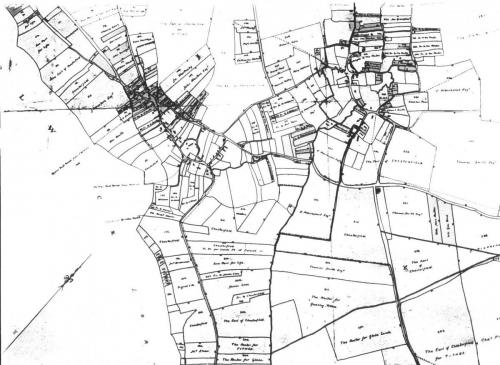
Bridgford Hill House, East Bridgford
While there is not going to be a detailed comparison between Gedling House and Bridgford Hill, it is not possible when studying one to ignore the other. The reason for this is that they have been directly linked as an architectural design and are said to have been visible from one another as part of a combined landscape statement. The design for Gedling is said to be exactly the same as Bridgford Hill.
The estate also came into existence through the changes brought about by the Enclosure Award of 1801 (Tate 1935 90). The history and architecture of Bridgford Hill has not been investigated in any great depth.
Bridgford Hill (Fig 11), looking over Shelford and the Trent Valley, was built by the Reverend Thomas Beaumont on a small property adjoining the Rectory known as Jackson’s Close and Orchard. It was bought from Henry Blagg, to which he added Kirkhill Common, part of the Holme, the East Wong and old highway to the Ferry (Du Boulay Hill 1932 50).
The Enclosure Award of 1801 records that Beaumont had exchanged Jackson’s Orchard, Jackson’s Close and Kirk Hill Close. The Rectory was leased by Beaumont as a girls school from 1792 until 1827.
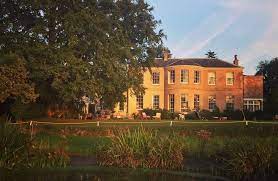
In the notes of the Reverend Arthur Du Boulay Hill lodged at the archive office it is alleged that in building his new house on Jackson’s Orchard he stopped a right of entrance to the Rectory on that side, built a laundry on Rectorial land, and further encroached on the glebe territory (NAO: PR 6603).
Reverend Thomas Beaumont was the curate-in-charge of East Bridgford parish during the last 35 years of the incumbency of a non-resident rector, Peter Broughton, who died in 1827. He lived at Bridgford Hill until his death in 1835.
The house was left to his nephew, Mr George Beaumont (died 1882), whose son George followed, he died 1899, and his widow occupied the house until her death. The house was sold in 1908 to Mr W.A.Hodges, and in 1922 to Mr W.E.Claye (Hill ibid). The date for the construction of Bridgford Hill has been given as c.1792 (ibid; Pevsner 1979) , the year that the Reverend Beaumont moved to East Bridgford.
The East Bridgford Enclosure map, surveyed in 1796, shows the land to be awarded from Henry Blagg to Thomas Beaumont in exchange for other lands (Fig 12). It is clearer here than at Gedling House that the Enclosure was used to amalgamate adjoining land in order to make a unified property.
The Land Tax assessment for East Bridgford gives some interesting information about the possible date of its construction (Appendix 1 B). Thomas Beaumont is first assessed in 1794 at 4 shillings, at which level he remains until after 1796, when he jumps to £2 16s 1d. The rise in his assessment resulting from the land gained at the Enclosure Award. This could suggest that Bridgford Hill was built in either 1794, when Beaumont is first assessed, or after 1796 when his land holdings have increased.
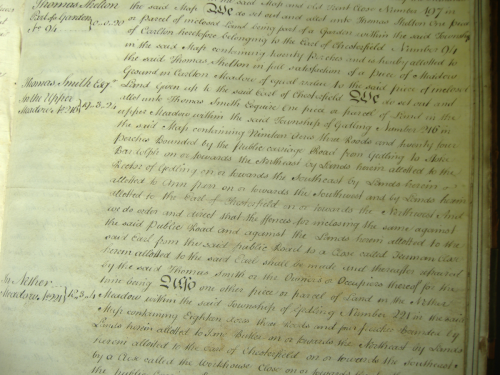
The connections between the Gedling and East Bridgford houses may be followed further through the family connections. Thomas Smith is directly connected to East Bridgford as a major land owner there, which he owned until 1803, the same year that Gedling House was sold. He is mentioned as owner of both properties in a number of documents.
By 1802 Smith had his land tax in Gedling and East Bridgford redeemed for £15 8s 3p. The ‘Certificate of the Contract for the Redemption of Land Tax’, signed in December 1799, lists both estates (NRO: DD.LK/50/51).
In an examination of George Mellows, on the 19th January 1801, he states that he was hired to Thomas Smith to serve at his farm in East Bridgford. Mellows served at East Bridgford until June when he moved to his masters house in Gedling until Martinmas, the 11th November, by which time the sowing of corn should be complete (Samuels 1984 42-3).
These two documents show that despite a profusion of Thomas Smiths in Nottinghamshire at this time, a direct link between the owner of the properties in Gedling and East Bridgford. Thomas Smith is also linked to the Beaumont family through marriage as his grandfather, Abel Smith, married Jane Beaumont in 1713 (Gascoyne 1912 88).
It is unclear if this connection through marriage provided a lasting link between the families or is of any great consequence for the connection between the designs of the two houses.
Marriages of the female Beaumont’s provide a number of family links between the two houses and to James Paine junior. In 1784 Charlotte Beaumont married the Reverend John Swete, who undertook at least one painting of Gedling House (Fig 4) and, in 1788 her sister, Francis Beaumont, married William E. Elliott. Both of these couples were married by the Reverend Thomas Beaumont.
The Reverend Swete lived at Oxton House, Kenton, Devon (Fig 13). When he died in 1844 William E. Elliott left John Swete, of Oxton House, £2,000 (NAO: M2097).
Peter Leach has described how Swete rebuilt Oxton House in 1781 and laid out the grounds c.1792, including a number of ornamental structures in the gothic style. Some of the work may have been undertaken by James Paine junior although Leach states that the house is not in Paine’s architectural style (1984 398).
Both the Reverends Swete and Beaumont are cousin’s to James Paine junior (ibid 398, 400). The Paine and Swete connections are discussed further in chapter three.
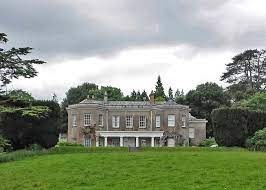
Architects and Builders.
While it has been possible to discover during this research that it was Thomas Smith who had the house built it is less certain who designed and undertook the building work for Smith and who undertook the improvements for William E. Elliott.
Nikolaus Pevsner informs us that the Reverend Thomas Beaumont, who built Bridgford Hill in 1792, was a friend of James Paine junior (1745-1829), who may have helped in the design. The plans were then used again at Gedling House, but with the extra storey (Pevsner 1979 113, 131).
Peter Leach adds that Thomas Beaumont was in fact a cousin of Paine,
“but the house bears no relation to his style.” (1984 note 400).
By the 1790s Paine had given up trying to pursue his architectural career to concentrate on painting topographical watercolours (ibid 392). Paine worked in a style that followed on from his more illustrious father with embellishments and plans that called on Palladian and Greek Revival influences, but was happier as a sculptor and painter (Colvin 1979).
The Reverend John Swete, a close relation of both Thomas Beaumont and James Paine, can be seen as a more likely influence upon the design of both Bridgford Hill and Gedling House.
Swete was married to Charlotte Beaumont in 1784 at St Nicholas’ church in Nottingham and Thomas Beaumont officiated. Thomas Beaumont also officiated at the marriage of William Elliott Stanford (later Elliott) and Frances Beaumont in 1788. These marriages show the close ties between Swete, the Beaumonts and William E. Elliott.
That the Reverend Swete painted at least one watercolour that included Gedling House shows he had a knowledge and interest in the building and landscape. Swete was a noted antiquary, topographical artist, and according to John Claudius Loudon was
“an excellent artist in landscape architecture” (Leach 1984 398; Pevsner 1952 224).
Richard Polwhele, an acquaintance of Swete, said in 1793 that the work was
“planned by the present possessor and executed under his inspection” (quoted by Leach ibid).
He later worked on the grounds, replacing the
‘formal terraces, cropt hedges, and yew-tree monsters’ which had been there before 1803 (quoted by Pevsner ibid).
Oxton House is a plain two storey structure with a pair of full height canted bays to the front which contain a single-storey Greek Doric portico covering five bays between them. The portico and certain later garden structures may have been designed by James Paine junior after 1803 (Leach ibid).
What all this tells us is that the Reverend Swete was an experienced amateur landscape architect who was connected to the owners of both Bridgford Hill and Gedling House. Abigail Gawthern informs us that he was present in Nottingham in April 1804, preaching at St Nicholas’ church (Henstock 1980 107).
It is hard to escape from the conclusion deriving from an abundance of circumstantial evidence that the Reverend Swete at the very least, provided advice, and is likely to have been well aware of the potential impact that was possible with the house and grounds. It is debatable as to the extent to which he may have influenced the final design.
Oxton House, Kenton, Devon built 1781 by Reverend John Swete.
What can only be guessed at is the extent to which the main influence where the two owners themselves. While they may only have commissioned the work and overseen its completion, on the other hand they may have been responsible for the complete design of the estate.
As rich landowners they are quite likely have wanted to show their wealth and learning by making use of an architect or someone knowledgeable in architecture. The leading builders in Nottingham in the late eighteenth century were Samuel and William Stretton. While there is no direct link between the Stretton’s and the construction of Gedling House there is circumstantial evidence that hints towards but does not prove a connection.
In 1776 Samuel Stretton [1732-1811] rebuilt Colwick Hall (Fig 14) for John Musters to the design of John Carr of York (Pevsner 1979 251). While Colwick is more ornate and on a larger scale than Gedling House there are similarities between the basic designs. Gedling could be seen as a smaller Colwick Hall stripped of its superfluous classical decoration. Of particular note are the single storey south wings at Colwick, with round-headed windows, which are very similar to the smaller wings on the south façade at Gedling.
Wilford Hall (Fig 15) was built by Stretton for Samuel Smith to designs by William Henderson of Loughborough in 1781 (Robinson 1910 227). While Wilford is a plain red brick Georgian house it provides a connection between Stretton and the Smith family, Samuel and Thomas Smith being cousins who appear to have had some close contact.
Abigail Gawthern also used the services of Stretton in May 1792 when she undertook work to her Castlegate home and, as has been seen in chapter two, she had some close associations with Thomas Smith and William E. Elliott.
While William Stretton [1755-1828] made comprehensive lists of what he considered his more important of the 1780s and 90s his list is incomplete (ibid), and both Samuel and William Stretton erected a number of gentlemen’s residences in and around Nottingham (Brand 1988 14). There are a number of other buildings with family connections that may have had some influence on the final look of Gedling House.
Pevsner suggests that Stanford House, 19 Castlegate (Fig 16) has window lintels which are a survival from the earlier Bromley House, Angel Row, while a central bow to the rear elevation is more up-to-date and Adamish (1979 234)
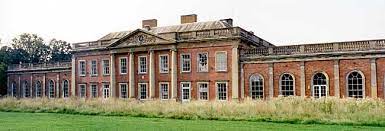
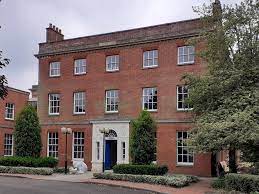
Stanford House was bought by William Stanford (Later William Elliott), father of William E. Elliott, in 1775 and completely remodelled between 1775 and 1785. Stanford House was owned until 1843 by William E. and John Elliott (Anon 1962). These provide an architectural link between the Smiths and Stanford/Elliotts and give a source of inspiration if it was William E. Elliott who added the central bow as the main feature of the south façade of Gedling House.
A final house and grounds that may have provided inspiration for William E. Elliott was built by the elder William Elliott in 1789-90, and called Radford Grove (Fig 17). He built a country seat and laid out the grounds with an artificial lake filled by the River Leen. Within the lake was an island on which was built an octagonal tower of brick and stone with a raised canopy roof.
In 1792, after William Elliott’s death, the estate was sold to a Charles Sutton or Smith, who let it to a man called Parr who set it up to become a popular tea-garden. In summer the lake was used for boating and in winter for skating. On one side of the lake was a wooden fence ornamented with a colourful painting of the Bay of Naples (Walker 1928 135). The gardens were closed by about 1840 (Meakin n.d.).
The house and grounds are no longer extant. Apparently one of the Elliotts had a daughter who drowned in the lake which may explain why it was sold in 1792 (LSL: Swann Scrapbook II 207).
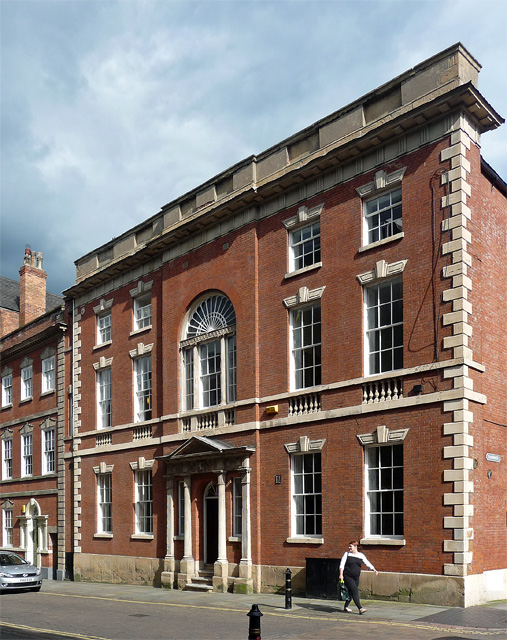
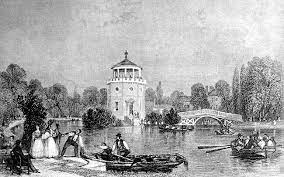
Architecture
The architecture of Gedling House is stylistically of the late Georgian or Regency period, which has led to the wide disparity between the dates of 1780 to 1820 previously given for the construction of the house.
By the time Gedling House was built the influence of Robert and James Adam was already felt on the building trade which led to a simpler adornment of buildings, much plainer buildings which used classical proportions to give elegance to the design, and by the 1790s was felt as a chaste neo-classicism with less luxury to be found in the decorative detail (Cruickshank 1986 85).
The designs were based on the study of the classical Greek and Roman archaeological remains still to be found, and not the earlier Palladian interpretation of them (Woodforde 1978 22).
General Description
Gedling House is constructed of brick, coated with stucco which is painted white. The stucco was probably first applied by William Elliott during his improvements of 1803-6 and, it is recorded as being painted white by ‘The Wanderer’ in 1835 (Baker 131). The roof is of hipped construction, with four stacks and has recently been re-covered with slates. A parapet hides the roof from close view. The main section carries deep modillioned eaves. An ashlar plinth completely circuits the base, while a band circuits the first floor.

The garden front (Fig 18), facing south towards the River Trent, has a central full height parapeted bow with three curved steps to a tall central sash. Flanking the bow are three sashes to each floor. To the east of the bow are two round-headed sash windows with Gothic glazing bars. It appears from the early watercolours that this motif was originally repeated on the west side.
There are seven sash windows on both the first and second floors, with the higher ones being shorter. The ballroom which was added to the west wing has square and canted bay windows with two casements and a French window which is flanked by single sashes. Although it was originally a lean-to glass-house it was converted into a ballroom early in the twentieth century by Walter Rawnsley.
Above the ballroom is a single sash, although originally there were two. The higher sash was used to provide access for a fire escape when the building was converted in the 1960s. To the east of the house is a coped brick wall with a door into the courtyard.
The entrance front (Fig 19), on the north side, has a central aediculated doorcase flanked by Doric columns and with a fanlight and open pediment above. It is interesting that a similar doorcase is contained in a contemporary pattern book of 1789 by William Pain (Fig 20). The door is flanked by three sashes, with six sashes to each of the floors above.
To the east is a stuccoed coach house with pyramid roof and a louvered roof vent, a side wall stack, and twentieth century garage doors. There is a round headed doorway giving access through the north wall.
Between the coach house and the main house is a two storey service wing with a louvered door and two sashes, and three smaller sashes above. The link to the main house has two sashes provided for each floor.
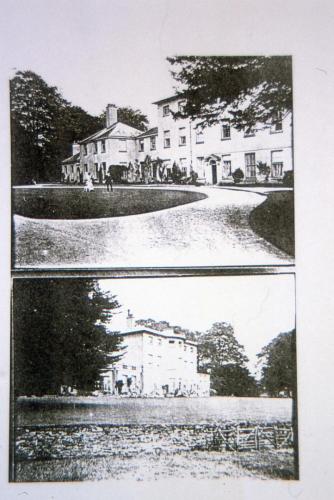
None of the original furnishings have survived the occupation by the War Department and the Educational Resources, but there is still some interesting fittings.
The panelled entrance hall (Fig 21) has a geometrical cantilevered wooden staircase with a scrolled and ramped handrail, and stick balusters which are square in plan (Fig 22). The early twentieth century ballroom has plaster wall panels and until recently a Baroque Revival style fireplace. At the time of this study the ballroom was particularly suffering from problems associated with dampness.
Other principal rooms have simple moulded wall panels and cornices. Many of the rooms throughout the house still contain the original late Georgian Classical fireplaces and hob grates and most of the rooms in the attic storey retain their hobs.
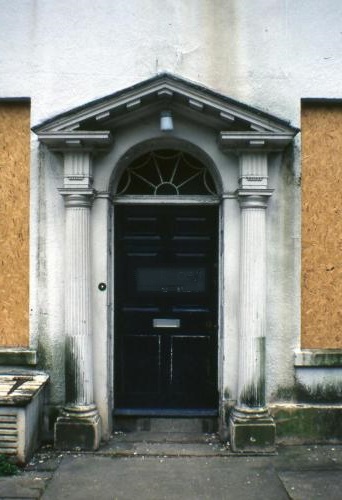
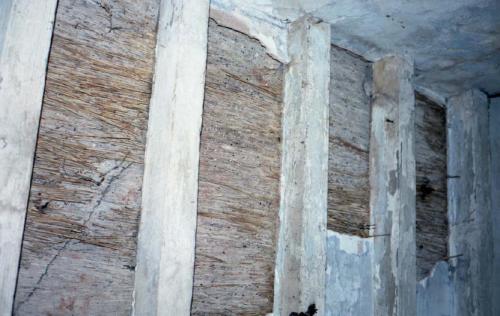
The central axis of the house is based on the entrance hall. A north-south axis runs from the main central doorway to the centre of the bow on the garden front, and an east-west axis runs through the centre of the house. The east-west axis is repeated to each storey as a corridor, providing access to all the rooms. On the eastern extensions the axis kinks slightly towards the north. With the changes being undertaken in 1995 all these axes will be lost as a unified element of the house.
Gedling House was designed between c.1795 to 1806, with further known modifications in 1844 and 1904. It is unclear as to what extent the final look of the house was part of the original design built for Thomas Smith, or part of the major changes undertaken by William E. Elliott. For instance, Elliott may have had the stucco applied, added the pedimented doorcase, added the western extension.
Figure missing
Fig 22 Geometrical, cantilevered wooden staircase in Entrance Hall, with scrolled and ramped handrail.
Stucco
J.Gwynne in London and Westminster Improved, 1766, says that
‘no publick edifice ought to be built of brick unless it is afterwards stucco’d, for a mere brick face… makes a mean appearance.’ (quoted in Hussey 1955, 27).
The same opinion was also generally held towards country houses. It was during the 1760s that stucco was invented and patented, with the Adams making it a popular fashion where stone could not be used – usually due to cost (ibid.). The stucco may have been applied as part of the original building in c.1795 or as part of the restyling by William E. Elliott between 1803-6.
The Bow
It is the elegant full height centrally placed bow in the garden front, on an axis with the main entrance hall, that provides the main focus of interest to the south facade. The bow was a popular motif in English Georgian houses from c.1750. Elliptical bows enjoyed a vogue from c.1790 to 1830 (Cruickshank 1985 42).
In chapter four it was noted that the Reverend John Swete placed two full height canted bays either side of the main façade when he rebuilt Oxton House for himself in the 1780s (Fig 13). If the bay and bow was a favourite motif of Swetes’ then it might be that it was he who advised on the design of the bow.
It has already been noted that William Elliott, father of William E. Elliott, added a central bow to the garden façade of Stanford House, Castlegate, Nottingham before 1780.
Ballroom and Regency Green-House
The painting of ‘The Seat of W.E.Elliott’ by an unknown artist clearly depicts a lean-to greenhouse on the west side of the house (Fig 18). The Ordnance Survey maps of Gedling House show a glasshouse in this position until 1900, after when it was converted by Walter Henry Rawnsley into a ballroom (Fig 10).
It is still in the form of an Edwardian ballroom, which until recently contained an elaborate Neo-Baroque fireplace. The fireplace was stolen when the house was vacant. It is the most ornately decorated of the rooms in the house which is due to its later date of construction.
The greenhouse is referred to in the 1803 sale catalogue as adjoining the drawing-room so was probably part of the original building erected for Thomas Smith, and can be dated to the mid-1790s. The specific use of the greenhouse is not mentioned, although it is likely to have housed less exotic plants than a conservatory.
Humphrey Repton wrote in 1802
“There is no ornament of a flower-garden more appropriate than a conservatory, or a green-house, where the flower garden is not too far from the house; but, amongst the refinements of modern luxury may be reckoned that of attaching a green-house to some room in the mansion” (Repton 1803 217).
Most greenhouses had to be lean-to well into the Victorian period (Stuart 1979 136).
Principal Rooms
A plan of the layout of the rooms for each floor is provided in Figure 23. The first description of the use to which the rooms in the house are put is provided by the 1803 sale catalogue which lists the,
“Dining-room, Drawing-room, with Green-house adjoining; Breakfast-room, Parlour, Hall, two Staircases, Pantry, Store-rooms, Kitchen, Laundry, Brewhouse, Dairy, and sundry other convenient Offices; seven Bed-rooms, Water-closet, Servants’ Bed-rooms, three good Cellars, and lower Dairy” (NAO: DD.LK. 50/53).
From this and later interviews with servants and relatives of Sir John Turney it is possible to see the uses to which the rooms were put at various times. The upper rooms were used as bedrooms for the servants and the nursery for the children.
The first floor, of nine rooms and a lobby, was also for bedrooms, but for the adults and guests. This floor also had the one bathroom that was provided for the house. The dining room, used for the evening meal, and is identified by twentieth century interviews as being next to the kitchen.
Until the 1790s a common practice was to turn a room into a dining room as was convenient rather than having a fixed room and it was common to find the dining room on the first floor (Cruickshank 1990 54)
Guests would have assembled for dinner in the drawing room, to where the polite company would also withdraw after dinner, which with the green house attached might have allowed the owner to best show his more exotic plants while entertaining. As the southern of the two rooms adjoining the glasshouse has more ornate plasterwork this might be the drawing room, although, the plaster is probably later.
The breakfast room, suggests a less formal room was originally used for breakfast and may have been used for dining when the family was not entertaining. The parlour was the front or best room of the house.
The entrance hall is later described as being full of trophies but is unlikely to have had such Victorian decoration in the Regency period. Other rooms described in the sale catalogue are likely to have been arranged around the room which is still identifiable as having been the kitchen (Fig 24) and the open courtyard.
Figure missing
Fig 23 Gedling House, Plan of floors and rooms. (not to scale).
Stairs
The sale catalogue of 1803 records that there are two stairs, while now there are three stairs, and the possible site of a fourth in the western annex. Presumably the catalogue does not include the stairs down to the cellar.
The main stair in the panelled hall to the first floor is a cantilevered wooden staircase with stick balusters and a scrolled and ramped handrail (Fig 22). The handrails and balusters were replaced during the repair work of 1966 (Swain 1966).
The other stairs are much simpler dog-leg affairs tucked away as they are not there to make an impression but just to connect the floors and were primarily for the use of the servants (Fig 24).
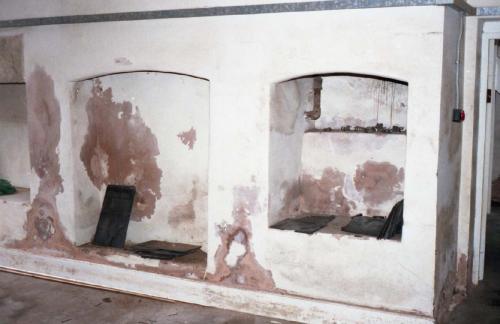
figure missing
Fig 25 Stairs up to the Second Floor.
Windows
The sash windows of the garden façade are of particular interest because they show something of the ‘Battle of the Styles’ that developed through the first half of the nineteenth century. The main façade has correctly proportioned classical windows, while the single storey wings are Gothic (Fig 26).
From the early nineteenth century painting the south wall of the green house can be seen originally to have had Gothic windows (Fig 18). This reveals the awareness at the time of the developing arguments between the two styles while showing that the owners were not averse to taking a non-partisan view and adding whichever style they saw fit.
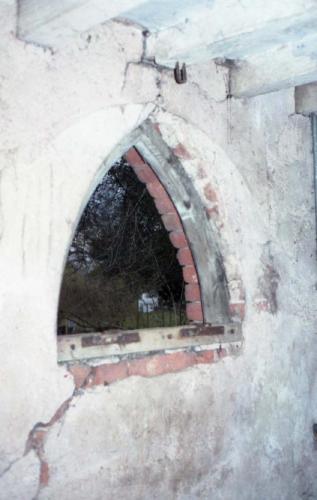
Doors
“If a facade could have only one ornament during the Georgian period, that ornament would generally be the doorway. No matter how economical the structure, nor how austere the design, it was practically inevitable that at least a little extravagance and a little freedom of design would be allowed for the door.” (Cruickshank & Wild 1986 82).
And so it is at Gedling House, with the only slight expression, on an otherwise pure façade, being the entrance. It is fairly clear that the design for the door is based upon a design in a pattern book by William Pain (fig 20). While there are clearly differences between the detail of the door on plan and that which was executed, such as the fluting on the actual columns, and the variations between the fanlights.
Internally the doors are a complete mix from 1960s fire doors, to original Georgian doors with their fittings.
Fireplaces
Some of the best surviving authentic Georgian features of Gedling House are the fireplaces, although, as has already been mentioned above, the grandest of them have recently been stolen. The fire became the central feature to a room so it is no wonder that they received most decoration.
In the late eighteenth century the free-standing fire grate was replaced with a fixed grate, usually with bars that bowed and sometimes with a pierced apron. For the bedroom and less important living rooms the hob grate started to be used.
The ducks-nest grate was a popular form, in the form of a double semi-circle (Fig 27a,b). Front casings were embellished in high relief for polishing with black lead (Woodforde 1978 125). Marble was used for the fireplaces as part of the simple classical designs.
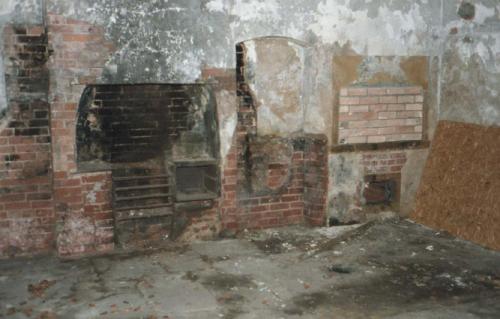
figure missing
Fig 27b Fireplace: duck’s nest hob grates, showing a double semi-circle to be found in a variety of designs.
figure missing
Fig 28 Fireplace: with Gothic designs on surround.
figure missing
Fig 29 Fireplace: With classical decorations, derived from Adam. Bears name Smith on the base.
Mouldings and Plasterwork
The main ground floor rooms have fairly plain mouldings on the walls and cornice. It is the cornices, between the wall and ceiling, that have received most treatment and in some cases have dentils. most cornices have some decoration.
The later decoration in the ballroom is more ornate and this has been repeated in the room adjoining. The main rooms have chair-rails to prevent damage to the plasterwork by chairs.
figure missing
Fig 30 Mouldings above the main staircase in the entrance hall.
Gardens & Grounds
The Gedling House estate was built up in the mid to late-eighteenth century by the Smiths, with some additions in the nineteenth century by William Elliott. The extent of the grounds can be reconstructed from contemporary sources; deeds, maps, paintings, the 1803 sale catalogue and, the few contemporary accounts. Although the estate no longer forms a single unified element it can still be traced in outline on the ground as well.
From the surviving elements it would appear that the owners were subject to the general influences of Georgian gardening fashions to an extent, but were not averse to utilising outdated trends where it suited their needs, such as the belts of trees on the south and west used to separate the estate from views to the workhouse.
The grounds are designed to aid the house in making a statement in the Trent Valley as it can be seen for a good distance it visibly impacts on the surrounding villages, those on the opposing side of the Trent Valley, and on the approaches to Gedling.
During the time that Gedling House was being laid out the ideas behind landscape design were going through something of an overhaul. Lancelot Brown died in 1783 and a debate on what should replace the Brownian garden style was carried out between Humphrey Repton, Uvedale Price and Richard Payne Knight.
David Stuart says there were three shifts of direction effecting garden design at this time. The first was part of the Romantic movement, with an elevation of intuition over reason led to ideas of the Sublime. The second came from an awareness of the natural world, a belief in the superiority of the primitive, giving neo-classicism and the Greek Revival. Finally, there was an increased number of plants introduced into gardens, elevating the idea of diversity into gardens (1979 80-3).
While many of the aesthetic ideas behind late eighteenth century gardening are not now seen at Gedling House, those ideas that led to more concrete remains can be seen. During the 1790s the kitchen garden, stables, conservatories were all being moved back and attached to the main residence (ibid 76).
The Landscape – The Trent Valley.
The garden and house have been designed to be seen as a unified whole, and it has been recorded that they were intended to be visible from Bridgford Hill House. Gedling House is certainly still visible from parts of East Bridgford.
The main landscape difference between Bridgford Hill and Gedling House is their siting in relation to the valley sides. Gedling House sits about a third of the way up the slope (Fig 1), while Bridgford Hill sits at the top (Fig 31). Both houses are now set against dark trees.
The possibility that the layout of the estate had at some point a unified design within the constraints of the topography was mentioned in chapter two. It is now difficult to disentangle who provided the main creative drive behind the development of Gedling House as a planned landscape. While Thomas Smith built up the estate from his inheritance, it may have been William E. Elliott and the Reverend John Swete who had the combined imagination to provide the picturesque view.

The sale catalogue of 1803 describes the grounds as Thomas Smith finished them,
“The Mansion-House, fronting South-East, is seated in the centre of rather more than 70A. of Land, comprised within a Ring-fence (and which will be sold with the House) forming a handsome Lawn in Front, with several thriving Plantations, and commanding an extensive and very beautiful prospect over the River Trent, and adjacent rich Vales, abounding with Game, and highly desirable to Gentlemen fond of Field Sport and Fishing” (NAO DD.LK 50/53).
Garden Buildings
The two early paintings of Gedling House both show a garden temple sitting on the hillside. It is most clearly shown on the painting by an unknown artist entitled the ‘Seat of W.E. Elliott Esq.’ (Fig 18). This dates the temple to the period of Elliott’s occupancy or earlier. That it is also on the Rev Swete painting suggests the temple might form part of the improvements undertaken by Elliott recorded by Abigail Gawthern in 1806 (Henstock 1980 123).
Matthew Henry Baker, as The Wanderer, described numerous walks in the vicinity of Nottingham, one of which included the following description of a view towards Gedling from the Trent,
“The path in the fourth close is upon the banks of the Trent, and in proceeding, the village of Gedling comes more into site. The white house of W.E.Elliott, Esq. and the small temple at the angular point of two Plantations, that meet near the summit of the hill, have a pretty appearance.” (1835 131)
Baker considered the walk, from Colwick to Shelford via Stoke Bardolph ferry, to be one of the most delightfully pleasant around Nottingham (ibid 130).
The 1835 map by Sanderson (Fig 7) does not record the temple, although a ‘Summer House’ is recorded in the grounds of Bridgford Hill, which from its position commanded views towards Shelford and Gedling. None of the later maps show the temple, and it is not clear at what time it vanished.
Although the temple appears in two paintings its form cannot be clearly interpreted, but does appear to be of circular plan with round headed or gothic door and windows and a circular roof with some form of pinnacle. The roof seems to be held up by thin posts or columns. The whole is placed on a levelled platform.
The structure would have enjoyed views towards the River Trent, Nottingham and East Bridgford, although judging from where it would have been only Nottingham and the Trent are visible as the woods have grown to the east.
It is known that the Reverend John Swete was a keen landscape artist and gardener and in c. 1792 laid out the grounds of his own property, Oxton House, Devon, including a number of ornamental structures in the gothic style (Leach 1984 398). It is quite possible that Swete, with his very close family connections, advised and designed the temple for Elliott, and the paintings may have been commissioned to show the temple before or after it was built to best show its impact on the landscape.
The elder William Elliott, who died in 1792, built pleasure grounds at Radford Grove or Folly, Nottingham from 1780 after his retirement. The centre-piece was a boating lake overlooked by a large octagonal temple (Fig 17). Could this have provided the inspiration for William E. Elliott to have erected the Gedling temple. It may have had sentimental attachments as there is an unsubstantiated report that the daughter of one of the Elliott’s is said to have drowned herself in the lake (LSL: Swann Scrapbook II 207).
The house and grounds were sold to Charles Sutton on the death of William Elliott in 1792 (ibid).
There are numerous other buildings within the garden area that are recorded on the Ordnance Survey map, but which are now demolished or in a state of disrepair. William E. Elliott’s will refers to outbuildings and the 1803 sale catalogue to
“a very convenient detached Yard containing a double Coach- house, excellent Stables and Saddle-house, a large Barn, Dovecot, Cow- houses, and other Buildings, with Rooms over them; Gardens and Orchards well stocked.” (NAO: DD.LK 50/53).
As well as providing the garden for the house, there was also the need for the grounds to include and satisfy the requirements of a large thriving farm, and as can be seen from the description many of the ancillary buildings were actually part of the day- to-day business of running that farm. The farm buildings are now in a semi-ruinous state and have been for a long time, some being recorded as such earlier this century Ordnance Survey maps.
They were probably allowed to decay as the property stopped being the centre of the farm and simply a residence.
It is possible that in the farm buildings something of the original style favoured by Thomas Smith is revealed, especially in the windows which are in a more Palladian taste, abounding in Diocletian windows (Fig 32) and Serliana (Fig 33).
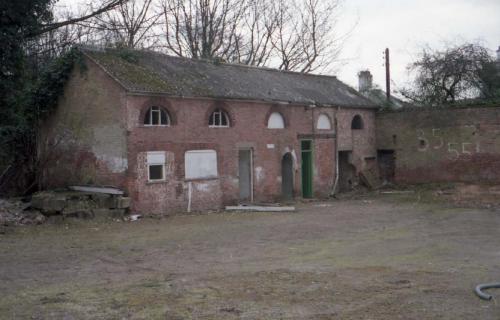
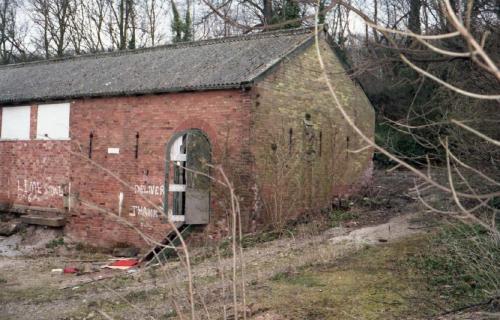
The Kitchen Garden
To the east of the house lies the walled kitchen garden, originally reached by a path to an entrance to the middle of the south wall (Fig 34). It is all now somewhat overgrown. Internally the garden has lost all of its structures and the form of its layout.
The buildings have been lost through neglect and vandalism while the layout has gone as it is all now overgrown. Fortunately the nineteenth century Ordnance Survey maps record in some detail the paths, glass-houses, and buildings that were then present (Fig 10).
Enough of the structures survive on the ground and as ghost outlines on the walls for them to be reconstructed (Fig 35).
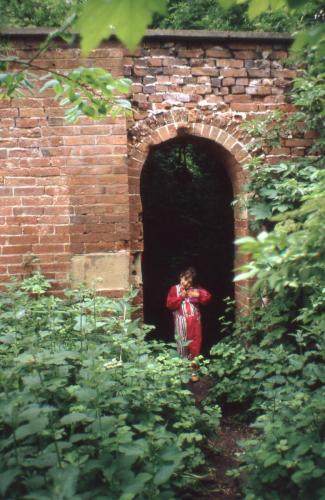
Walled gardens have a fairly standard form throughout the Georgian period and that attached to Gedling House seems fairly typical, being rectangular. It is c.300′ east to west and c.150′ north to south. The entrance is through an open doorway in the south wall (Fig 34) which was the least useful part and would have provided the visitor with a view of the most productive parts and the glasshouses on the north wall.
There are two round-headed doorways through the north wall which gave access to garden buildings, at least one of which appears to have been flued so as to provide heat through the wall to the lean-to greenhouse (Fig 36). In his will William E. Elliott refers to hothouses and greenhouses (NAO: M2097), the difference being that one just provides shelter while the other is heated to grow more exotic plants.
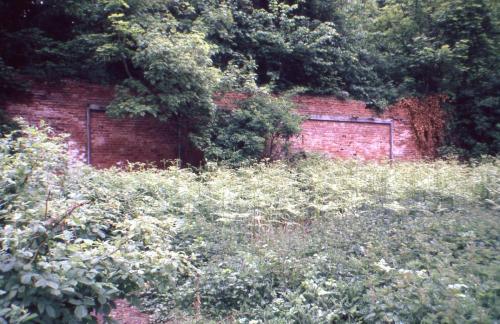
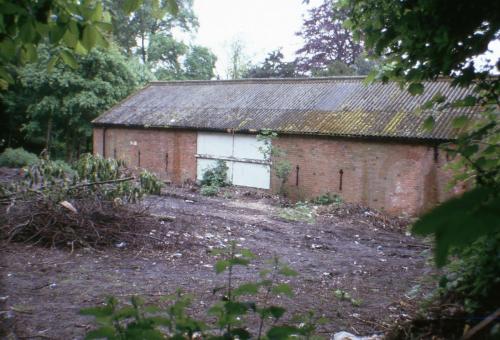
Boundaries: Terrace and Wood
A stone terrace obviated the need for a boundary wall around the immediate environs of the garden (Fig 37), providing an uninterrupted vista across the lawn and the Trent Valley from the south part of the house.
Repton wrote in 1803 that the
“boundary-fence of a place should be concealed from the house, is among the few general principles admitted in modern gardening” (198),
and in 1815 he states,
“If there be any part of my practice liable to the accusation of often advising the same thing at different places, it will be true in all that relates to my partiality for a terrace, as a fence near the house.” (Repton & Repton 416).
A second terrace is provided to the north of the house and kitchen garden and provides a barrier between the garden and woodland.
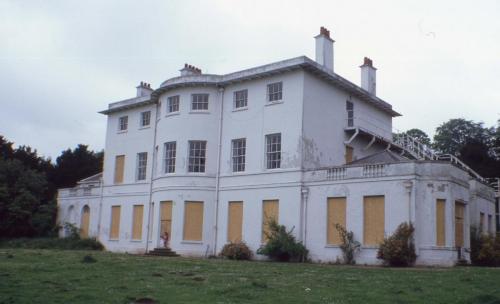
The original boundary, as described in the 1803 sale catalogue, comprised a ring-fence. Woodland was planted soon after the house was constructed both as a backdrop and as belts to delineate some of the boundaries. The main area of plantation lies to the north of the house and helps it to stand out.
The belts of trees lay to the south, on the north side of Burton Road and to the west, on the original boundary between Thomas Smith’s property and Hall Wongs belonging to the Earl of Chesterfield.
The use of such formal belts, in the style of Lancelot Brown, to delineate the edge of the estate park was already somewhat old fashioned, and was possibly being used because the owners wanted to hide less agreeable aspects of the view, such as the workhouse. The belts could also have been used because in certain respects the owner’s taste had not moved with the times.
At the north end of the property is a large plantation that was not present at the time of the enclosure award, but is present on all the nineteenth century maps. With the wars of the late eighteenth century wood became a scarce resource and during the 1790s the planting of trees became a national necessity and it was a patriotic duty to create woodland (Stuart 1979 108).
The Lodge, Gateway and Avenue
On what was the original south-west boundary of the estate is the Lodge and entrance gate (Fig 38). The Lodge is a single storey stuccoed building very much in keeping with the style of the main house. It is unclear of the precise date for the construction of the Lodge, but it does appear on the 1836 map.
The Lodge does not appear to be listed in the 1803 sale catalogue. It was therefore constructed by Smith or Elliott, and of these two the latter seems more likely. If Elliott was the builder then he probably had it built around 1805 when he undertook most of his changes. It does not appear on the Reverend Swete’s painting (Fig 4), but this might be because it is hidden behind the windmill.
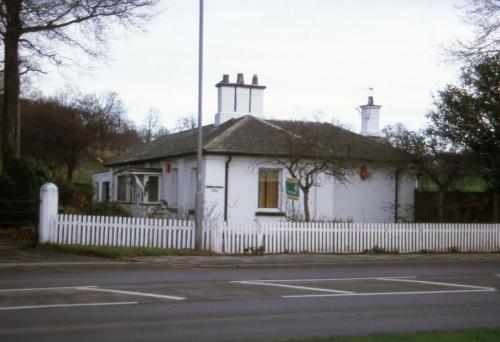
Where the occupiers of the Lodge can be traced through the national censuses of the nineteenth century they appear as servants or gardeners to Gedling House. It is unfortunate that in only two censuses, in 1851 and 1871, is the Lodge named, but in both cases the head of the household is recorded as a gardener.
The Lodge acts as a gatehouse for a tree-lined approach that runs along the western boundary of the estate and joined the main western approach. The gateway was a simple affair and consists of a plain farm gate between two stone posts. It is not clear as to the extent to which this approach formed the main entrance to the grounds and certainly by the late-nineteenth century it was little more than a footpath, and seems to have continued as such until the school was built.
Discussion
Gedling House is of interest for the way in which it and the owners responded to issues of the time; issues of polite parochial style and taste in architecture and changing economic, social and political events. In many ways the house can be read as a document of the Late Georgian and Regency period, a microcosm of taste and events.
By studying Gedling House and its estate I have tried to show how a late Georgian house developed and to look at the contemporary style and taste that influenced the final look of the estate. The house sit well within the perceptions of what makes a Regency-style house. The Greek revival doorcase with its Doric order columns is typical, as is the simple stucco façade broken only by the windows, doors and bow.
According to Woodforde a distinguishing feature of a Regency house is a large curved bow at the rear of the house facing the garden (1978 149). However, the owners were not averse to the introduction of simple pointed Gothic sash windows into the wings of a Greek revival façade. In the mix of Greek and Gothic the house shows something of the impending ‘Battle of the Styles’ that was to develop through the first half of the nineteenth century. The parochial attitude here seems to have been little perturbed by the mix of styles. Other influences may have been more personal allowing the use of the local experience of the owners and builders, so that elements in other Nottingham buildings might be seen in Gedling House.
The initial development of the estate can traced to the early eigthenth century to the involvement of an earlier Thomas Smith and Able Smith, bankers who provided mortgages to the landowners. As the land that belonged to the Smiths increased in Gedling and East Bridgford through the period until around 1780 when Thomas Smith, who built Gedling House, inherited the land, and consolidated it in the run up to the Enclosure Award of 1796.
It is interesting that both Gedling House and Bridgford Hill House had grounds that were built up just prior to the Enclosure. It shows an element of design being thought through in the minds of the owners in their desire to have a unified property centred around their main house. The houses were, of course, also the centre of thriving agricultural communities.
The best historic resource for showing the most plausible date for the building of Gedling House lies with the land tax assessments, of 1781-1832, which show that Thomas Smith was until 1795 living in Nottingham, and from that date in Gedling. From 1798 he is recorded as living in Gedling and East Bridgford. The land tax does not prove the date of construction, especially as he could have inhabited one of his other three properties in Gedling. The house was certainly constructed before 1798 when Smith took out a mortgage to cover his liabilities as the distributor of stamps and his land tax was redeemed.
That Thomas Smith built Gedling House is almost beyond doubt but it is not so clear and unequivocal regarding which designed elements of the estate can be ascribed to Smith and which are Elliotts. It is interesting that the farm buildings exhibit a Palladian taste while the main house is more of the Regency. It might be that the older style, harking back to Andreas Palladio, was that originally used for the facades on the main house but this was modernised during the ownership of William E. Elliott.
Abigail Gawthern testified that the house and gardens were upgraded by Elliott although the extent of the work is not made clear.
Both of the two early owners inherited substantial parts of large fortunes that were made during the eighteenth century as part of the expansion of commerce and industry during the ‘industrial revolution’. The increased wealth and prosperity of the middle classes throughout England at this time allowed for the construction and remodelling of country mansions and estates, including Gedling House. The increased wealth of the middle classes allowed them to indulge their greater sophistication in a lifestyle which can still be seen as expressed in buildings and gardens of fashionable taste.
Other national trends that influenced landscape design at this time was the wood shortage that led to the planting of woodland as a patriotic duty in order to supply the needs of the navy in the numerous eighteenth century wars, allowing the owners to provide a backdrop to the house and fulfil their duty as faithful Tories.
As well as allowing for the owners being aware of changes in taste, a parochial inertia in taste can be seen in elements that are based on local fashion and which are picked up by the owners from local buildings. This can be seen in the builder using but stripping down and building on a smaller scale the facades at Colwick Hall, and the possibility that Elliott had the bow constructed, based upon the bow to be found at the rear of Stanford House, which he grew up in and later owned with his brother.
The owners are relatively easy to trace, but the sources of inspiration for the designs are not. Bridgford Hill House, designed by the reverend Thomas Beaumont, has been previously given as the source from which the plans for Gedling House were taken and then expanded. Links between the two houses are provided by Thomas Smith having substantial land holdings in East Bridgford which would have meant that, at the very least, he was aware of any new building by Beaumont.
Closer ties are provided by William E. Elliott who was married to Thomas Beaumont’s sister, Frances, in 1788. There appears to be closer links between Bridgford Hill and Elliott, than with Thomas Smith. It is possible that the house was bought in 1803 because it was visible from East Bridgford and changes were made so that the garden fronts became similar.
Apart from the owners there are a number of their contemporaries who could have had an influence on the design and layout of Gedling House. James Paine junior is mentioned by Pevsner (1979 113) as helping Thomas Beaumont in designing Bridgford Hill. Paine, who was a cousin of Beaumonts, can be seen as a possible but unlikely design source for Gedling House.
Another close relation, the reverend John Swete, not only painted Gedling House, but was also a noted painter of landscape architecture. Swete designed his own house and gardens in Devon. He seems to be a much more likely inspiration behind the design of the houses and gardens in Gedling and East Bridgford.
The Strettons were the most noted builders of Nottingham in the late Georgian period, and evidence of their involvement in building Gedling House might be seen through superficial similarities with other Nottinghamshire buildings they were involved with. The use of builders pattern books is noticeable in the design of the front door.
After the development of the house, garden and grounds in the first decade of the nineteenth century, very little seems to have occurred, except as new owners inherited the estate they immediately made some changes. The later changes have not been properly recorded and were generally fairly minor, not disrupting the Regency air of the place.
The houses of Georgian Nottinghamshire
“show us how graceful, how stately, life could be for the fortunate minority in Georgian England. Their mellow brick, the quiet grandeur of classical doorways and big sash windows, all the handsome details of ironwork, fanlights, staircases, the generous airy rooms, exhibit that effortless assurance and disciplined opulence, that exquisite combination of artistic form with ease and comfort which to our less ordered age is one of the most attractive features of the eighteenth century.” (Wood 1947 266).
Appendixes
APPENDIX ONE A: LAND TAX ASSESSMENT 1781-1804 [NAO: QDE 1/4 1781-1832]
LAND TAX : GEDLING
- DATE PROPRIETOR OCCUPIER ASSESSMENT
- 1781 Thomas Smith Thomas Hallam 1-9-6
- 1782 Thomas Smith Thomas Hallam 1-9-6
- 1783 Thomas Smith Thomas Hallam 1-9-6
- 1784 Thomas Smith Thomas Hallam 1-9-6
- 1785 Thomas Smith Thomas Hallam 1-9-6
- 1786 Thomas Smith Thomas Hallam 1-9-6
- 1787 Thomas Smith Thomas Hallam 1-9-6
- 1789 Thomas Smith Thomas Hallam 1-9-6
- 1790 Thomas Smith Thomas Hallam 2-4-7½
- 1791 Thomas Smith Thomas Hallam 2-4-9½
- 1792 Thomas Smith Thomas Hallam 2-4-9¾
- 1793 Thomas Smith not recorded
- 1794 Thomas Smith Thomas Hallam 2-4-9¾
- 1795 Thomas Smith Thomas Hallam 2-4-9¾
- 1796 Thomas Smith Himself 2-4-9¾
- 1797 Thomas Smith Himself 2-4-9¾
- 1798 Thomas Smith Himself 2-4-9¾
- 1799 Thomas Smith Himself 2-4-9¾
- 1800 Thomas Smith Himself 2-4-9¾
- 1801 Thomas Smith Himself 2-4-9¾
- 1802 Thomas Smith Himself Redeemeed
- 1803 Thomas Smith Himself Redeemed
- 1804 WE Elliott Himself Redeemed
APPENDIX ONE B:
LAND TAX : EAST BRIDGFORD
- DATE PROPRIETOR OCCUPIER ASSESSMENT
- 1791 Mr Broughton, rector Henry Grooms 3-14-6 Mr Blagg John Holland 1- 9-2½ Mr Smith Mrs Newdigate 1-16-10 – no Beaumont
- 1792 Mr Broughton, rector Henry Grooms? 3-14-6 Mr Blagg John Holland 1- 9-2½ Mr Smith Mrs Newdigate 1-16-10 – no Beaumont
- 1794 Mr Broughton, rector Henry Grooms? 3-14-6 Mr Blagg Himself 1-10-? Mr Smith Mrs Valines? 1-16-10 Mr Beaumont Himself 0- 4-0
- 1795 Mr Broughton, rector Henry Grooms? 3-14-6 Mr Blagg Himself 1-10-5½ Mr Smith Mr Palmer 1-16-10 Mr Beaumont Himself 0- 4-0
- 1796 Mr Broughton, rector Mr Beaumont 3-14-6 Mr Blagg Himself 1-10-5½ Mr Palmer Himself 1-16-10 Thomas Smith not recorded – Palmer is Mr Beaumont Himself 0- 4-0
- 1798 Thomas Beaumont Himself 2-16-1 Thomas Smith Himself 1-16-10 Henry Blagg Himself 1-16-6
- 1799 The Rector Various 16-4-6 Thomas Beaumont Himself 1-13-6 Thomas Smith Himself 4-16-4
- 1800 The Rector Various 16-4-6 Thomas Beaumont Himself 1-13-6 Thomas Smith Himself 4-16-4 John Jelly Revd T Beaumont -8-4 Revd J Walter ” ” ” -14-6
- 1801 Thomas Beaumont Himself 1-13-6 Thomas Smith Himself 4-16-4 John Jelly Revd T Beaumont – 8-4 Revd J Walter ” ” ” -14-6
- 1802 Rev.Thomas Beaumont Himself Redeemed Thomas Smith Himself Redeemed John Jelly Revd T Beaumont – 8-4
- 1803 Rev.Thomas Beaumont Himself Redeemed Thomas Smith Himself Redeemed John Jelly Revd T Beaumont – 8-4
- 1804 Rev.Thomas Beaumont Himself Redeemed Wm. Hurst(for Smith) Himself Redeemed John Jelly Revd T Beaumont – 8-4 – no Thomas Smith, replaced by William Hurst
APPENDIX TWO: OCCUPIERS OF GEDLING HOUSE – DIRECTORY INFORMATION
- 1832 White’s William Elliott ELLIOTT
- 1844 William Stanford BURNSIDE
- 1848 White’s William Stanford BURNSIDE
- 1853 White’s William Stanford BURNSIDE
- 1858 William Stanford BURNSIDE
- 1864 White’s William Stanford BURNSIDE
- 1865 White’s William Stanford BURNSIDE
- 1868 Wright’s William Stanford BURNSIDE
- 1869 William Stanford BURNSIDE
- 1874 John BURNSIDE
- 1876 John Elliott BURNSIDE
- 1877 John Elliott BURNSIDE
- 1879 John Elliott BURNSIDE
- 1885 White’s John Elliott BURNSIDE Principal landowner => William Elliott BURNSIDE
- 1893 John Elliott BURNSIDE
- 1894 White’s John Elliott BURNSIDE
- 1902 Wright’s John Elliott BURNSIDE
- 1902/3 John Elliott BURNSIDE
- 1903 John Elliott BURNSIDE
- 1904 Walter Hugh RAWNSLEY (& Well Vale, Alford)
- 1905-6 Walter Hugh RAWNSLEY,J.P.
- 1907-8 “Residence of Sir John TURNEY”
- 1908 “Property of W.H.RAWNSLEY, now occupied by Sir John TURNEY,J.P.
- 1912 “Property of W.H.RAWNSLEY, now occupied by Sir John TURNEY,J.P.
- 1920 “Residence of Sir John TURNEY”
- 1925 “Property of W.H.RAWNSLEY, now occupied by Sir John TURNEY,J.P.
- 1928 “Owned by W.H.RAWNSLEY, but unoccupied”
- 1932 “Property of W.H. RAWNSLEY is now unoccupied”
- 1936 Lt.Col John William Carnegie KIRK, D.S.O and Norman Pilkington HAYNES
- 1941 “Residence of Norman Pilkington HAYNES & Lt.Col. John William Carnegie KIRK, D.S.O
APPENDIX THREE A:SMITH FAMILY TREE:
John Smith 1592-1642 | | Thomas Smith 1631-1699 | | | | | | | | | Thomas Smith Samuel Smith Abel Smith 1682-1727 -1751 -1757 m. Jane Beaumont | | | | | | | | | | Sir George Smith, bart John Smith Abel Smith mp Thomas Smith -1769 1716- 1717-88 1719- | | | | | | | | | | | | | | | | | | | | | | Sir George Bromley, bart Thomas Smith Thomas Abel Robert Samuel John George 1753-1808 [?] -1769 -1779 Lord Carrington 1754-1834 1767-184? 1768-1831 | m. Mary Bigsby 1752-1838 | | | | 1765 | | | V | | | | | | | | | | | | | | Thomas Mary George Robert Thomas 1768/71 1774-1843 1778-1806 APPENDIX THREE B:STANFORD/ELLIOTT/BURNSIDE/RAWNSLEY FAMILY TREE: John & Mary Elliott | | | | | | | | WILLIAM ELLIOTT 1704-1792 Godfrey Elliott Thomas Elliott Penelope Wedg 1733 1696- ? 1701-1750s | | | | William Elliott ANN ELLIOTT | | bapt 12/04/1735 [?] | | m. WILLIAM STANFORD 1751 Thomas Stanford [1730-1796] (1792=ELLIOTT) [ -1799] | Ann Palmer 1761 | | | | | | | | | | Penelope Stanford WILLIAM ELLIOTT STANFORD John Stanford ANN STANFORD [1752- ] [1756-1844] 1796=ELLIOTT [1757-1823] [ John Toppat 1777 Frances Beaumont 1788 1796=ELLIOTT JOHN BURNSIDE [ – 1836 1786 | | | | | | | | | | | Penelope Burnside William Stanford Burnside Rev. John Burnside Catherine Elizabeth [1789] [1791-1870] [1792-1864] Burnside [1794- Mary Gillol Henrietta Anne Julia Thompson S|r Willingham Franklin [1795-1820 or 1860] [1794-1849] | | | | | | | | | | | | | | | | | | | | | | | | | | | Rev William John Elliott-m1-Julia Georgiana Katherine Frances Emily Mary Sophia Ann Adelaide Catherine Ann Elliott Burnside Burnside | Burnside Burnside Burnside Burnside Burnside Franklin | [1818-1883] [1817-1904] | [1821-1887] [1825-1845] [1830-1876] [1831-1876] [?] m. Rev Robert | 2.Mary Gillol | Byron Dummond Burwell | | RAWNSLEY | William Elliott Burnside [1845-1911]
APPENDIX FOUR: 1803 SALE CATALOGUE (NAO: DD/LK/50.50)
APPENDIX FIVE: Gedling Estate in 1868.
LAO: PR 17,250
Gedling House Survey book of Gedling parish (excludes Carlton and Stoke) giving field names, field cultivation (arable, pasture, garden etc) acreages, names of owners and occupiers and number in rate book. Goes with map (GE 1R), by John Bausor, Land Surveyor & Valuer, Nottingham 1868. Deposited with Nottingham Archive Office by Gedling District Council.
1. Name or Situation of Each Field or Parcel of Property.
2. Description or Mode of Cultivation of Each Field or Parcel of Property.
3. Number on Map.
4. Quantity of Each Field or Each Parcel if Seperately Rated.
5. Total Quantity in Each Holding.
6. Name and Situation of Each Holding Seperately Rated. ALL GEDLING
7. Description of Each Property.
8. Name of Occupier.
9. Name of Owner. ALL WILLIAM BURNSIDE ESQ
10.Number in Rate Book.
1. 2. 3. 4. 5. 6. 7. 8. 9. 10. Lodge House Garden 343 – – 15 House & Mr Alvey 3 & Garden Land Cottage & Garden pt354 – – 18½ House & Mr Attlewell Berry 3 Garden Land Garden Garden 185 1 – 19 Land In Hand 3 Plantation Wood 344 1 – 31 Wood ” 3 Park Grass & 345 21 1 15 Land ” 3 Arable Plantation Wood 346 1 – 26 Wood ” 3 Meadow Grass 348 3 – 9 Land ” 3 Plantation Wood 349 – – 3 Wood ” 3 & Shed Hall Farm Gardens 350 9 3 17 House & ” 3 Buildings, Land Pleasure Ground,Plantation & Gardens Plantation Wood 355 – – 34 Wood ” 3 65 – 23 Cottage & Garden 356 – – 27½ House & Thomas Griffin 4 Garden Land Cottage & Garden pt354 – – 18½ House & Robert Sutton 5? Garden Land Honey Pot Arable 184 5 2 37 Land John Tomlinson 6 Close Workhouse Pasture 205 6 – 32 Land ” ” 6 Meadow Workhouse Pasture 206 5 3 22 Land ” ” 6 Meadow Workhouse Pasture 215 5 2 18 Land ” ” 6 Meadow Stoke Lane Arable 223 5 1 31 Land ” ” 6 Meaow Long Meadow Pasture 233 9 1 4 Land ” ” 6 Middle Pasture 234 5 1 16 Land ” ” 6 Meadow Hall Wong Meadow 342 7 2 30 Land ” ” 6 Pasture Pasture 353 3 3 31 Land ” ” 6 Close House Farm Gardens 357 – 2 10 House & ” ” 6 Buildings Land Stackyard, 55 2 31 Orchards, Gardens, etc.
Bibliography
- Anon. 1962 Stanford House, 19, Castlegate, A Brief History of Ownership. unpublished manuscript
- Baker, Matthew Henry. 1835 Walks Around Nottingham by the Wanderer. Wilson, Simpson & Marshall, Nottingham.
- Barley, M.W. & Straw, I. 1969 ‘Nottingham’ in Lobel, M.D. (ed.) Historic Towns.
- Barley, M.W. & Train, K.S. 1972 Thoroton’s 1677 Antiquities of Nottinghamshire, Edited and Updated by John Throsby (1790-1796). Scolar Press, Nottingham.
- Beckett, J.V. 1990 ‘Nottinghamshire in the 1790s.’ Trans. Thoroton Society of Nottinghamshire. 94: 47-61.
- Beckett, John. 1990 The Book of Nottingham. Barracuda, Buckingham.
- Brand, Ken. 1983 ‘Turneys.’ Nottm. Civic Society Newsletter 72:
- Brand, Ken. 1988 ‘The Strettons of Lenton.’ Nottm. Civic Society Newsletter. 76: 13-18.
- Brand, Ken n.d. Thomas Chambers Hine: An Architect of Victorian Nottingham. (2nd Edtn.) Nottingham Civic Society, Nottingham.
- Briscoe, J. Potter. 1901 Contemporary Biographies.
- Brown, Cornelius. 1882 Lifes of Nottinghamshire Worthies and Celebrities. Southeran, Nottingham.
- Burton, Elizabeth. 1967 The Georgians at Home 1714-1830. Longman, London.
- Chalkin, C.W. 1974 The Provincial Towns of Georgian England: A Study of the Building Process. Edward Arnold, London
- Chambers, J.D. 1932 Nottinghamshire in the Eighteenth Century: A Study of Life and Labour Under the Squirearchy. PS King & Son, London
- Chapman, Stanley D. 1967 The Early Factory Masters: The Transition to the Factory System in the Midlands Textile Industry. David & Charles, Newton Abbot.
- Colvin, H.M. 1979 Biographical Dictionary of British Architects 1600-1840. John Murray, London.
- Cruickshank, Dan. 1985 The National Trust Guide to the Georgian Buildings of Britain and Ireland.Weidenfeld & Nicolson, London.
- Cruickshank, Dan & Burton, Neil. 1990 Life in the Georgian City. Penguin, London.
- Cruickshank, Dan & Wyld, Peter. 1975 Georgian Townhouses and their Details. Butterworth Architecture, London.
- DoE 1987 List of Buildings of Special Architectural or Historic Interest, Borough of Gedling (Nottinghamshire). Dept. of the Environment.
- Easton, Harry Tucker. 1903 The History of a Banking Family. Blades, London.
- Felkin, William. 1867 History of the Machine-Wrought Hosiery and Lace Manufacturers. Longmans Green, Nottingham.
- Field, Henry. 1880 The Date-Book of Remarkable and Memorable Events Connected with Nottingham and its Neighbourhood, 1750-1879, From Authentic Records. H.Field, Nottingham.
- Gascoyne, George F. 1912 ‘Addenda re Bromley House.’ Trans. Thoroton Society of Nottinghamshire. 16: 88-90.
- Gerring, Charles 1908 A History of Gedling. Privately Published, Gedling.
- Gill, Harry. 1907 ‘Notes on Domestic Architecture of Old Nottingham.’ Trans. Thoroton Society of Nottinghamshire. 11: 99-116.
- Gill, Harry. 1912 ‘Nottingham in the Eigtheenth Century, Especially with Reference to Domestic Architecture.’ Trans. Thoroton Society of Nottinghamshire. 16: 41-87.
- Gill, Harry. 1915 ‘Colwick Hall and Church.’ Trans. Thoroton Society of Nottinghamshire. 19:35-46.
- Gill, Harry. 1916 ‘Notes on the Leen and its Buildings.’ Trans. Thoroton Society of Nottinghamshire. 20: 1-46.
- Girouard, Mark. 1980 Life in the English Country House. Penguin, London.
- Henstock, Adrian (ed.). 1980 The Diary of Abigail Gawthern of Nottingham 1751-1810. Thoroton Society Record Series 33. Nottingham
- Henstock, Adrian. 1988 Tracing the History of your House, Documentary Sources for the History of Nottinghamshire Buildings. Notts. Local History Association, Nottingham.
- Henstock, Adrian. 1980 ‘Town Houses and Society in Georgian County Towns: Architecture.’ The Local Historian. 14:2.
- Hill, Rev., A. Du Boulay. 1923 ‘The Rectors of East Bridgford.’ Trans. Thoroton Socirety of Nottinghamshire. 27: 73-105.
- Hill, Rev., A. Du Boulay. East Bridgford, Nottinghamshire, The Story of an English Village. Oxford University Press, London.
- Hoskins, Neville. 1991 ‘The Best Built House in Town.’ in Coope, R.T. & Corbett, J.Y. (eds.) Bromley House 1752-1991. Nottingham Subscription Library, Nottingham.
- Hussey, C. 1955 English Country Houses Vol II, Mid Georgian 1760-1800. Country Life, London.
- Leach, Peter. 1984 ‘James Paine Junior: An Unbuilt Architect.’ Architectural History. 27: 392-405.
- Leighton-Boyce, J.A.S.L. 1958 Smiths the Bankers. National Provincial Bank, London.
- Loudon, J.C. 1840 The Landscape Gardening and Landscape Architecture of the Late Humphrey Reton, Esq. Being His Entire Works on These Subjects. Longman, Edinburgh.
- Meaby, K.T. 1946 Nottinghamshire County Records of the Eighteenth Century.
- Meaby, K.T. 1952 Abstract of the Title of Major Richard Chaplin Rawnsley to Land Situate at Gedling in the County of Nottingham. unpublished manuscript.
- Monsarrat, Nicholas. 1966 Life is a Four-Letter Word. Vol I. Breaking In. Cassel, London.
- Norfolk, W.R. 1963 Gedling and Carlton: Some Aspects of Local History. Nottinghamshire Education Committee, Nottingham.
- Pevsner, N. 1952 The Buildings of England, South Devon. Penguin, London.
- Pevsner, N. & Williamson, E. 1979 The Buildings of England, Nottinghamshire. Penguin, London.
- Polwhele, Richard. 1793 The History of Devonshire, Vol II. Cadell, Dilly and Murray, London.
- Quinney, Anthoney. 1989 Period Houses, A Guide to Authentic Architectural Features. George Philip, London.
- Reade, Compton. 1902 The Smith Family. Elliott Stock, London
- Reed, M. 1983 The Georgian Triumph 1700-1830. Routledge, London.
- Rees, H.D. 1988 Inventory of Directories Available in Nottinghamshire, 1783-1976. Notts. Industrial Archaeology Society, Nottingham
- Reid, R. 1989 The Georgian House and its Details.
- Repton, Humphrey. 1795 Sketches and Hints on Landscape Gardening reprinted in Loudon J.C. 1840.
- Repton, Humphrey. 1803 Observations on the Theory and Practice of Lanscape Gardening. reprinted in Loudon, J.C. 1840.
- Repton, Humphrey & Repton J.A. 1816 Fragments on the Theory and Practice of Landscape Gardening. reprinted in Loudon, J.C. 1840
- Richardson, A.E. 1946 Decorative Detail of the Eighteenth Century by William and James Paine. Tiranti, London.
- Robinson, G.C. 1910 The Stretton Manuscripts. privately published, Nottingham.
- Samuels, John. (ed.) 1985 Life and Landscape in East Bridgford 1600-1900 WEA, Nottingham.
- Stuart, David C. 1979 Georgian Gardens. Robert Hale, London.
- Swann, F.M. 1979 The Story of Gedling, A Village in Nottinghamshire. Swann, Nottingham.
- Tate, W.E. 1935 Parliamentary Land Enclosures in the County of Nottinghamshire (1743-1868). Thoroton Society Record Series 5. Nottingham.
- Thomis, Malcolm. 1969 Politics and Society in Nottingham 1785-1835. Basil Blackwell, Oxford.
- Walker, John Holland. 1928 Links With Old Nottingham.
- Wells, R.A.E. 1983 Riot and Political Disaffection in Nottinghamshire in the Age of Revolutiion 1776-1803: The Origins of Nottinghamshire Radicalism. University of Nottingham, Nottingham.
- White, Francis & Co. 1832 Nottinghamshire: History, Directory and Gazetteer of the County, and of the Tow and County of the Town of Nottingham… Francis & John White, Sheffield.
- Woodforde, John. 1985 Georgian Houses For All. Routledge & Kegan Paul, London.
- Wylie, William Howie 1853 Old and New Nottingham. Longman, London.